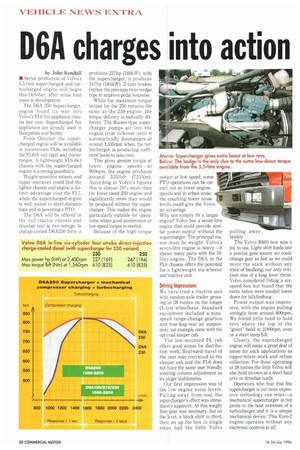D6A charges into action
Page 22

If you've noticed an error in this article please click here to report it so we can fix it.
by John Kendall • Series production of Volvo's 5.5-litre supercharged and turbocharged engine will begin this October, after some four years in development.
The D6A 250 Supercharger, engine found its way into Volvo's FL6 fire appliance chassis last year. Supercharged fire appliances are already used in Hampshire and Surrey.
From October the supercharged engine will be available in mainstream FL6s including the FL618 4x2 rigid and tractor ranges. A lightweight FL6 6x4 chassis with the supercharged engine is a strong possibility.
Weight-sensitive mixers and tipper operators could find the lighter chassis and engine a distinct advantage over the FI,7, while the supercharged engine is well suited to short-distance runs and in powering a PTO.
The D6A will be offered in the 4x2 tractor chassis and drawbar unit in two ratings. In charge-cooled D6A230 form it produces 227hp (169kW); with the supercharger, it produces 247hp (184kW). Z-cam brakes replace the previous twin-wedge type to improve pedal response.
While the maximum torque output for the 250 remains the same as the 230 engine, the torque delivery is radically different. The Rootes-type supercharger pumps air into the engine from tickover until it automatically disengages at around 1,535rpm when, the turbocharger is producing sufficient boost to take over.
This gives greater torque at lower engine speeds—at 900rpm, the engine produces around 5351bft (725Nm). According to Volvo's figures this is almost 70% more than the lower-rated 230 engine and significantly more than would be produced without the supercharger. This makes the engine particularly suitable for operations where good acceleration or low-speed torque is needed.
Because of the high torque output at low speed, some PTO operations can be carried out at lower engine speeds and in urban areas the resulting lower noise levels could give the Volvo an advantage.
Why not simply fit a larger engine? Volvo has a seven-litre engine that could provide similar power output without the supercharger. The principal reason must be weight. Volvo's seven-litre engine is heavy—it shares many parts with the 10litre engine. The NA in the FL6 chassis offers the potential for a lightweight six-wheeler and tractive unit,
Driving Impressions We have tried a tractive unit with tandem-axle trailer grossing at 28 tonnes on the longer (3.4m) wheelbase. Standard equipment included a ninespeed range-change gearbox and four-bag rear air suspension; our example came with the optional sleeper cab.
The low-mounted FL cab offers good access for distribution work. Rearward travel of the seat was restricted in the sleeper cab and the FL6 does not have the same user friendly steering column adjustment as its larger stablemates.
Our first impression was of the low engine noise levels. Pulling away from rest, the supercharger's effect was immediately apparent. At this weight first gear was necessary, but on the level, a block shift to third, then on up the box in single steps had the little Volvo pulling away briskly .
The Volvo R800 box was a joy to use. Light shift loads and a precise gate meant we could change gear as fast as we could move the stick without any trace of baulking; our only criticism was of a long lever throw. Volvo considered fitting a sixspeed box but found that the extra ratios were needed lower down for hiliclimbing.
Power output was impressive, with the engine pulling strongly from around 800rpm. We found little need to hold revs above the top of the "green" band at 2,000rpm, even on a short steep hill.
Clearly, the supercharged engine will make a great deal of sense for such applications as tipper/mixer work and refuse collection. For those operating at 28 tonnes the little Volvo will also hold its own as a short haul artic or drawbar outfit.
Operators who fear that the supercharger is yet more expensive technology can relax—a mechanical supercharger is not prone to the heat extremes of a turbocharger and it is a simple mechanical device. This Euro-2 engine operates without any electronic controls at all.












































































































